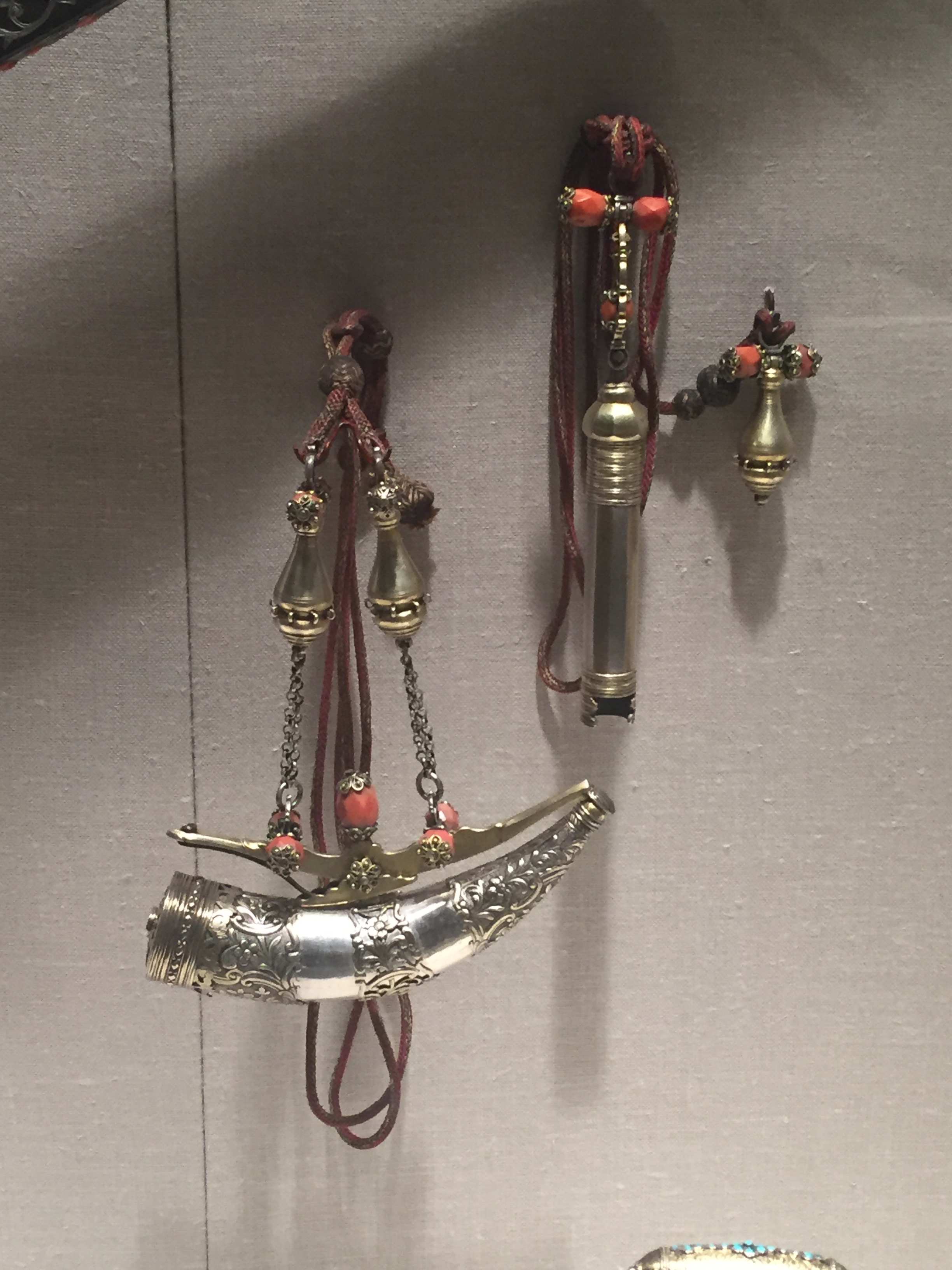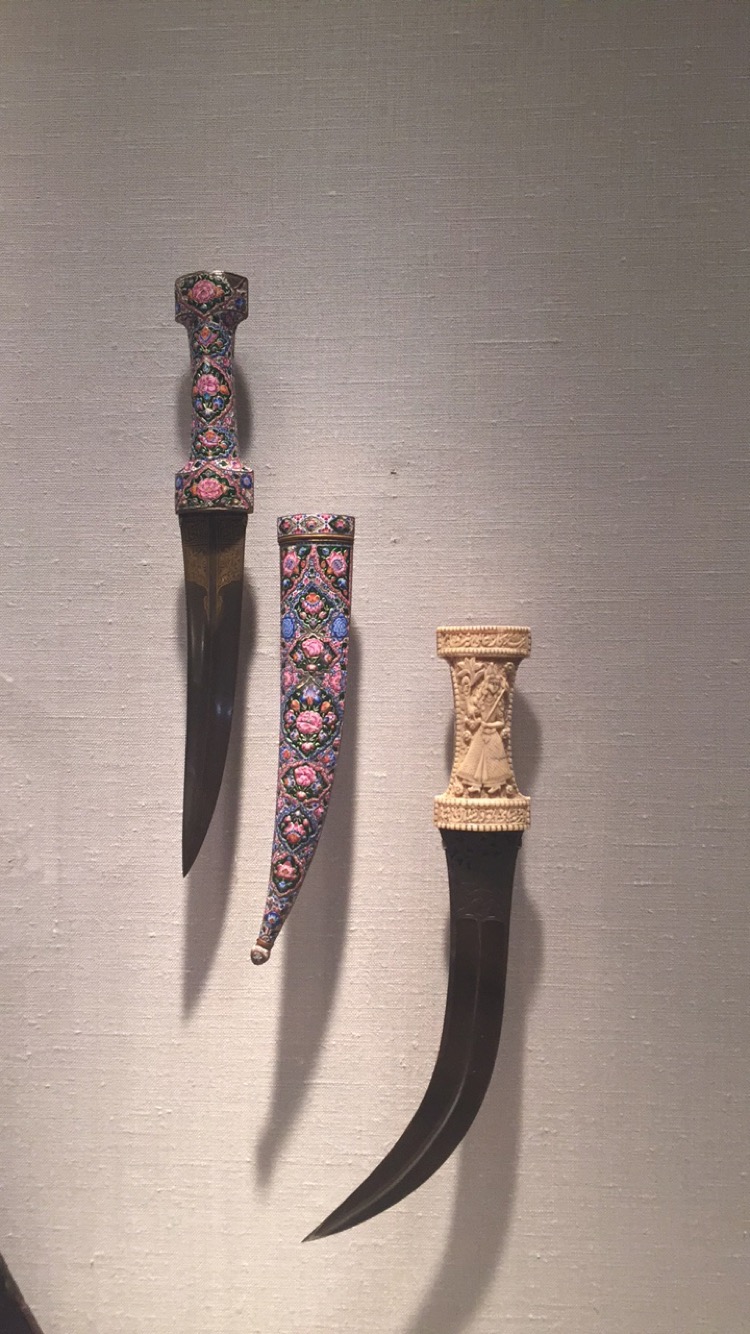This piece is a woman’s ceremonial underskirt worn that would have been worn by a woman in the Democratic Republic of Congo. The outside is made out of pineapple fibers which is what gives it the stiffness and interesting rigid structure.
This is an early 19th century Iranian helmet which was a functional object worn by soldiers in battle. It’s made out of steel and iron and references tradition because of the engravings from old stories and the fact that warfare was becoming increasingly more modern but armor was still being manufactured.
These beautifully decorative objects caught my eye immediately. I don’t know if they count as “wearables” but they were most likely attached to the body in some way. The items in the bottom picture are firearm accessories, meaning they hold the powder and assist in helping load and fire a gun. Middle eastern military wearables seemed to perfectly combine the idea of decoration and function which is something I hope to do in my piece. People often associate utilitarianism with simplicity and modernity, but I think an object can be both useful and beautiful while also being rooted in tradition or history. I also like the different media used in these pieces: the hard, sharply carved metal with the beautiful beads and sturdy cord used to hold the different elements together.
This sword and sheath from early 20th century Nigeria is another example of decoration and adornment meeting utilitarianism. I’m not quite sure how well this object functioned because it seems cumbersome, but it is certainly a beautifully crafted object.
The idea of a full body covering, similar to contemporary examples shown in class is interesting to me. This is a Portuguese set of armor that would have been worn by someone at a lower rank or at less risk of danger.
I have two main ideas for my own wearable.
Firstly, I was very inspired by the contemporary examples that were shown in class. I have been a fan of Nick Cave’s sound suits for a little while and am intrigued by the idea of a full body covering, head to toe. I want to channel Cave’s outlandish and larger than life outlook and make a functional object that happens to be head to toe. When I think of a problem in my everyday life that I would make an object to solve, I think about when it rains and how umbrellas, raincoats, and rain boots never really do a complete job of keeping me dry– at least one part of my body ends up getting soaked, whether that’s my jeans or my backpack or my head. What if I made a head to toe umbrella suit? I would use clear vinyl fabric (or some other textile that is water resistant and completely transparent) and build a wire “umbrella frame” out of 18 or 20 gauge wire. I’ll measure the different parts of my body to make sure that my suit covers all of me so that I can stay dry. The suit is meant to look kind of ridiculous kind of like Cave’s and Gene Pool’s work, but the object is completely functional.
The second idea I have is also a functional object but has more historical roots. When I was in the arms and armor wing of the Met, I noticed the very intricate plated hand guards that looked like metal gloves but with a detailed plated sleeve attached. I like the geometric way they are structured and attached to each other (with exposed attachments like screws or bolts) but preferred the more delicate details and mixed media aspect of the Middle Eastern military accessories like the knives and powder flasks. My own criteria for myself for this project is to make my object completely functional and solve an actual problem that I face. The metal armor gloves reminded me of oven mitts, so I think it would be interesting to make some sort of very structured oven mitt with plating, similar to the armor but with some sort of mixed media element or very intricate details like the Middle Eastern armor/accessories. In order to make these oven mitts, I would need to find some sort of textile that’s completely heat resistant, or find a way to treat a textile so that it becomes heat resistant.





